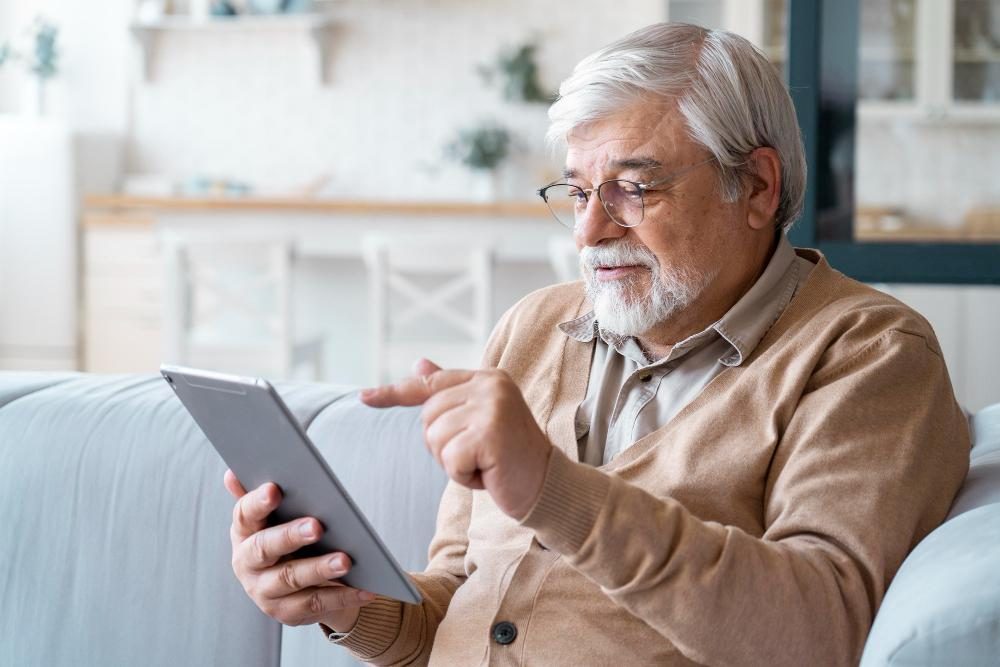
@ShahidNShah


In fact, 92% of elderly people prefer to spend their later years in their homes rather than in assisted living facilities. This requires some home improvements to keep senior people safe at home. As for those with limited mobility, modern assistive technology is engineered to maintain seniors’ independence. Let’s find out the most common devices that can enhance the elderly’s quality of life while managing mobility limitations.
Assistive technology for independent living represents specialized devices and systems designed to help individuals with physical limitations perform daily activities more easily and safely. Such technologies range from simple adaptive tools like voice-activated smart home devices and fully adjustable wide-seat power wheelchairs to complex integrated systems. They can monitor health, provide communication support, send reminders, and much more.
The top goal of assistive technology is to maximize an individual’s independence and, thus, reduce caregiver burden. This helps people with mobility restrictions to maintain dignity and self-sufficiency. By leveraging innovative technological solutions, seniors can overcome physical barriers, stay connected with their environment, and continue participating actively in their social lives.
Here are examples of efficient assistive technology useful for aging people with limited mobility.
Smart home devices with voice interactions have completely changed the way seniors engage with their homes. Smart speakers on the like of Amazon Echo or Google Home can be programmed to respond to basic voice commands. Such devices can turn on/off the light, regulate temperatures, or even lock doors. Smart home systems come in handy, especially at night when mobility is reduced and the risk of falls is high.
Automated home features add another level of independence for people with restricted mobility. Motion-sensor lighting eliminates the need to reach for switches, automatically illuminating pathways to prevent falls. In a smart home, appliances are self-adjusting. Smart appliances, such as self-adjusting ovens and refrigerators with water dispensers, minimize the need for bending. Automated window coverings help seniors regulate natural light and temperature without struggling with cords or reaching uncomfortable positions.
Modern mobility assistance devices go far beyond traditional walkers and wheelchairs. Some of the modern features include obstacle detection, an automated braking system, and adjustable positioning controls. Such advancements are to reduce strain on caregivers. Powered lift chairs enable smooth transitions from sitting to standing positions. Robotic walkers enhance stability and track the patient’s walking patterns in order to offer real-time feedback for improved safety.
Wearable technology brings peace of mind to both seniors and their families. Advanced fall detection gadgets promptly call for emergency services whenever a fall is detected. It becomes easier to check the location of your family members. This is especially useful for the elderly who may have issues with memory loss. Such an assistive device monitors the wearer’s well-being, including heart rate, sleep patterns, and activity levels. The gadget collects valuable data for healthcare providers to help seniors maintain optimal wellness routines.
Video communication platforms have revolutionized how elderly people stay connected with their dearest and nearest. User-friendly apps designed specifically for older adults feature larger buttons, simplified interfaces, and automatic answering options. Virtual social groups enable senior people to participate in book clubs or exercise classes situated near their homes. Telemedicine services reduce the need for physically demanding trips to medical offices – basic consultations can be done online.
Social support applications cover the day-to-day problems that elderly people with mobility impairments encounter. Reminder apps alert users and monitor adherence, minimizing confusion and missed doses. Grocery delivery services make complex shopping trips unnecessary – their friendly-designed apps ease the process of ordering basic goods. There are transportation services created for seniors that offer scheduled pick-ups for medical appointments and other social engagements. This is a nice alternative to get around when it is no longer safe to drive.
Remote monitoring systems provide comprehensive oversight without compromising privacy or independence. Activity tracking sensors detect changes in daily routines that might indicate health concerns. Vital sign monitoring equipment transmits important health data directly to healthcare providers – this allows for early intervention when problems arise. Emergency response systems include fall detection and medication monitoring. There’s a two-way communication feature that provides rapid assistance during a critical situation.
Smart medication management tools help seniors maintain complex treatment regimens with greater accuracy and less stress. Automated pill dispensers that dispense the right medications at specified times to avoid confusion. Smartphone applications integrated with medication regimens remind patients of their medication schedules and monitor their compliance. Medication tracking applications assist elderly patients and carers in tracking medication stock and scheduling refills to avoid disruptions in the use of necessary medication.
As elderly-friendly technology continues to advance, the future holds even more promising solutions for seniors with mobility challenges. From artificial intelligence-powered companion robots to smart clothing that monitors health indicators. Families exploring care options for seniors with limited mobility should consider how these technological solutions might complement traditional care approaches. With proper support and implementation, modern technology can help seniors maintain their dignity and connection to their communities despite mobility limitations.

A cybersecurity CEO offers advice on tactics healthcare CISOs and CIOs should use to protect sensitive telehealth data, and how providers can adopt a proactive security stance specific to virtual …
Posted Nov 19, 2024 Cybersecurity Telemedicine
Connecting innovation decision makers to authoritative information, institutions, people and insights.
Medigy accurately delivers healthcare and technology information, news and insight from around the world.
Medigy surfaces the world's best crowdsourced health tech offerings with social interactions and peer reviews.
© 2025 Netspective Foundation, Inc. All Rights Reserved.
Built on Apr 11, 2025 at 1:29pm